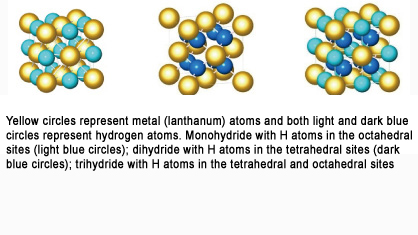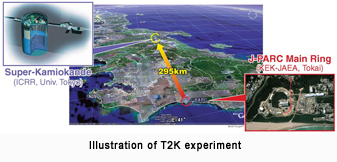| Hydrogen is one of the leading candidates as a source of clean energy for the future. Rare earth metals, such as lanthanum, have an extremely high affinity for hydrogen and readily form metal hydride complexes. Research aimed at exploiting these properties to develop hydrogen storage technology is proceeding apace. |
| In a world-first result, the High-Intensity Total Scattering instrument at the MLF, NOVA (BL21), in combination with experiments carried out at SPring-8, has played a vital role in confirming the existence under high pressure of the NaCl-type lanthanum monodueteride LaD (D = heavy hydrogen). This finding is consistent with the results of the first-principles calculations that demonstrate the NaCl-type LaH is stabilized at high pressures. |
| Previous work has revealed that the dihydride (LaH2) and trihydride (LaH3) forms of Lanthanum possess different hydrogen arrangements other than the NaCl-type. The current monohydride result shed light on investigations on the site-dependent nature of hydrogen-metal interactions and further on the discovery of an efficient hydrogen storage material. |
| This research was carried out as part of collaboration between JAEA, KEK, J-PARC Center, and Hiroshima University, the University of Tokyo and the University of Cambridge and was made possible with the support of the New Energy and industrial Technology Development Organization of Japan (NEDO). (Press release on May 7th 2012) |
 
|
| * Click here to enlarge. * Click here to enlarge.
|
| ▲to Page Top |
|
| ●T2K Collaboration Meeting Held at J-PARC in April |
| More than 150 researchers from around the world gathered in Tokai during 20-25 April to discuss the recent results and future direction of the T2K project. "T2K" (Tokai to Kamiokande) is a Japanese-led, multinational physics experiment designed to help unveil some of the mysteries of the elusive neutrino: one of the most basic elementary particles known to physicists. On the 8th of March 2012, the first high-intensity neutrino beam since the 2011 earthquake was fired from J-PARC towards Super-Kamiokande - the world's largest underground neutrino detector - which is located in Hida, 295km from Tokai. The ongoing T2K experiment aims to confirm earlier results that indicated the first observation of so-called "neutrino oscillation" - a phenomenon in which neutrinos periodically change and revert to type as they propagate. Click here for more detail on neutrino oscillation.
|
 
|
| * Click here to enlarge. * Click here to enlarge.
|
| ▲to Page Top |
|
| ●Prof. Walter Toki (Univ. of Colorado) delivers KICKOFF Seminar |
| Prof. Walter Toki of University of Colorado - a senior member of the T2K international team - presented a layman's introduction to the T2K experiment at the English-language KICKOFF Seminar on the 10th of May 2012. The KICKOFF Seminar Series is designed to promote international interaction and exchange in the Tokai research precinct and is regularly attended by a broad range of staff and visitors.
KICKOFF seminars are held at lunchtime on every other Thursday at the JAEA Tokai site.
|
|
| ●Emergency Evacuation Drill for J-PARC Users |
| Guaranteeing the safety of J-PARC staff and visitors is a top priority that was highlighted by the events of March 2011. J-PARC has implemented measures to ensure that strong and well-organized safety procedures are in place to respond quickly and reliably in the event of another emergency.
As part of these measures, J-PARC has established new "Tsunami Assembly Area"(s) around the experimental site and the dormitory. Recently J-PARC conducted a facility-wide evacuation drill in which over 350 staff and users took part. While we hope never to need these precautions, we are reassured by the efforts that have been made to strengthen the emergency response procedures.
|
|
|
|